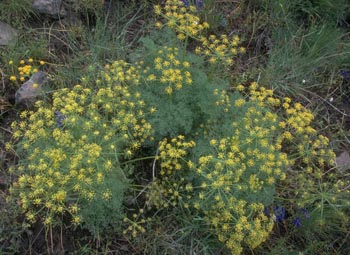Foothill Biscuitroot

Common Name(s):
Foothill Biscuitroot
Gray’s Biscuitroot
Foothill Desertparsley
Gray’s Desertparsley
Milfoil Lomatium
Gray’s Lomatium
Scientific Name:
Lomatium grayi (Coult. & Rose) Coult. & Rose
Scientific Name Synonyms:
None Known
Symbol:
LOGR
Description:
Life Span: Perennial
Origin: Native
Growth Characteristics: Foothill biscuitroot is a deciduous perennial that grow up to 3 feet high and 2 feet wide, with a strong, parsley-like odor.
Flowers: Mustard yellow flowers are found in umbels. The flower stalks are often lean.
Fruits/Seeds: The seeds are very similar to those of dill, and have papery “wings” which are thin and membranous.
Leaves: Leaves of foothill biscuitroot are subdivided into numerous, fine segments that turn in different planes, giving the plant a very thick, fern-like appearance. Leaves are bright, fresh green.
Stems: Biscuitroots have no real “stem”; the leaves and flower stalks instead arise directly from the crown of an exceptionally thick taproot. The stems of foothill biscuitroot are short and leafy.
Roots: Taproot
Ecological Adaptions:
Biscuitroots are often found in dry, open, often rocky areas. Foothill biscuitroot is found from lowland to middle elevations in the mountains, from 7000-8500 feet.
Soils: Biscuitroots can grow on a wide variety of soil types, but do require a well-drained soil. They prefer acid, neutral, and alkaline soils.
Associated Species: Poison hemlock, cow parsnip, pinyon pine, snowberry, big sagebrush. black sagebrush, Utah juniper
Uses and Management:
Foothill biscuitroot has low palatability.
The root of Foothill biscuitroot can be cooked and then be dried and ground into a powder which can be mixed with cereal flours or added to soups etc. It was often eaten by Native Americans in the winter when there was little other food available. The tender young stems can be eaten raw. It may also have been used as an aromatic flavouring in cooked foods.

